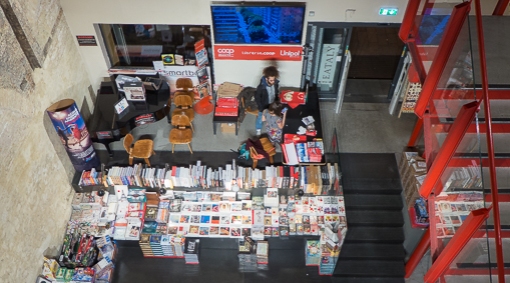This visit to London was made in December 2018. The post has been sitting around for a while. We hope the store survives the pandemic with enough local customers while the tourists who frequent Covent Garden are gone.

It was a long weekend. On our last day in London, we booked a place for brunch near Covent Garden. We were early and wandered around the area to discover a Mariage Frères shop.

The shop is very comfortably decorated with a cake counter upon entry, followed by a gallery which leads into a very airy salesroom.

This branch looks like the other shops in France, except it has a skylight which brings sunlight into the dark wood tea counter and wall of tea containers.

The shop has a tea house on the second floor but it was closed at that time. The tables at the tea house are lined up along the balcony which offer a view of the sales floor below.

According to Wikipedia, around 1660, Nicolas and Pierre Mariage began voyaging to the East on behalf of the French royal court. Successive generations of the Mariage family were in the tea trade and la maison was founded on 1 June 1854 by brothers Henri and Edouard Mariage.

It is France’s oldest importer of tea and in 1983 the company transformed itself from a wholesale import firm into a retail company.

The last owner descended from the founding family was Marthe Cottin. Born in 1901, she headed Mariage Frères until 1983. The year before, she found a Dutchman Richard Bueno and a Thai man Kitti Cha Sangmanee to carry on the legacy of Mariage Frères.

Competition in a tea-drinking country like the UK must be fierce. We saw but did not visit the huge TWG store near Leicester Square. TWG is established in Singapore just 10 years ago and has 70 branches, mostly in Asia.

Old-fashioned but effective. We did not see anyone using the scale but we suspect it is used for loose tea leaves.

The company has developed some 250+ tea blends based on tea from around the globe.

With so many varieties to try, it was hard to resist .. we managed by reminding ourselves that we have not finished some of their teas back home.

There is no Mariage Frères shop in Lausanne where we live, but we have a Kusmi store, a rival Parisian tea seller originally from Russia.

The tea house offerings look attractive but we already made plans for brunch. Well, next time.











 The different colorful plates added to the experience.
The different colorful plates added to the experience.




 Zhang Xueliang 張學良 was the effective ruler of Northeast China and much of northern China after the assassination of his father, Zhang Zuolin 張作霖 (the “Old Marshal”), by the Japanese on 4 June 1928. His father as a warlord was in 1920 the supreme ruler of Manchuria.
Zhang Xueliang 張學良 was the effective ruler of Northeast China and much of northern China after the assassination of his father, Zhang Zuolin 張作霖 (the “Old Marshal”), by the Japanese on 4 June 1928. His father as a warlord was in 1920 the supreme ruler of Manchuria.
























 From above, one could see the top tier of cars at a better angle.
From above, one could see the top tier of cars at a better angle.
 Most cars are German made understandably.
Most cars are German made understandably.



 Nice ambiance.
Nice ambiance.

 Oil rig
Oil rig
 .
.
 .
.
 .
.

























































































































































































